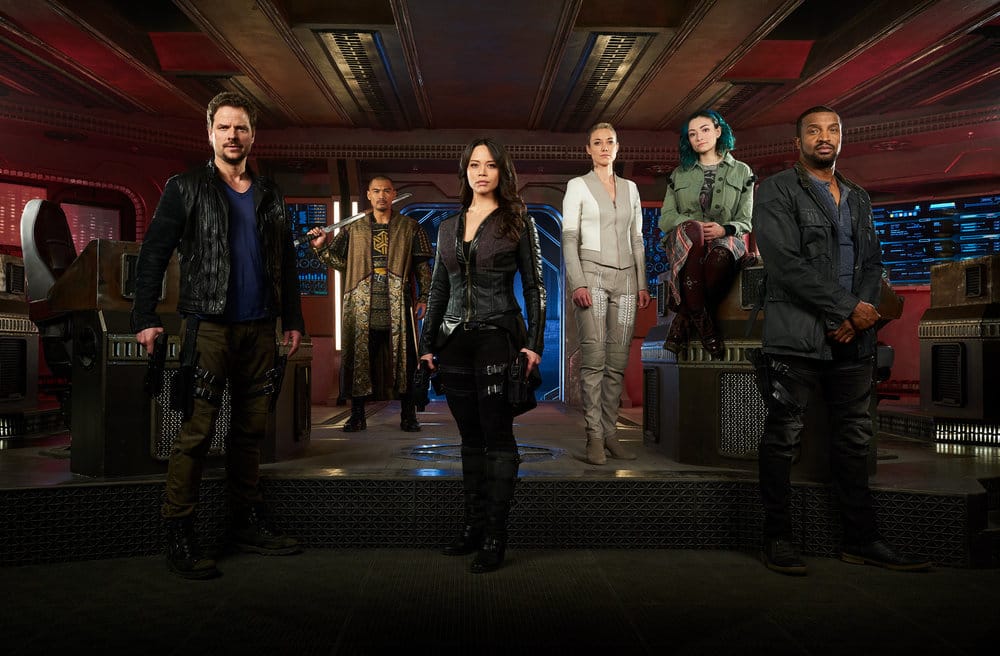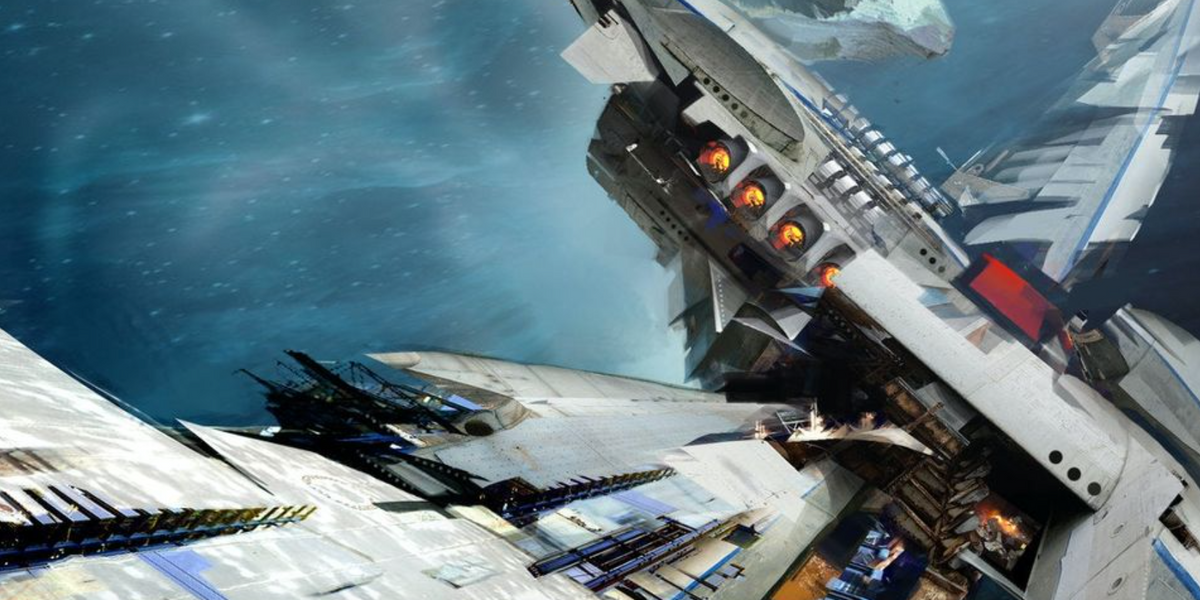How Dark Matter went from graphic novel to Syfy hit
A look back on the Syfy Channel's underrated space opera series

In 2016, the Syfy Channel's space opera series Dark Matter returned for its second season, bringing us back to follow the crew of the Raza as they embarked on another se of adventures. The action-heavy series about a mind-wiped crew who awakens aboard a derelict spaceship has played a key role in the resurgence of the cable channel, which returned to its science fiction roots with fervor in 2015, launching one ambitious new program after another, from Killjoys, to The Magicians, to The Expanse.

But the road that brought Dark Matter to television was anything but straight. As we gear up for more mysterious adventures, creator Joseph Mallozzi talks about how the series went from pitch, to the comic page, and finally, to the small screen.
Mallozzi joined the Stargate franchise as a producer in 2000, and played a part in expanding the series into two additional spinoffs, Stargate: Atlantis and Stargate: Universe. While working on the franchise, he began to develop the hook for a new show: a crew of six wake up on a starship. Their memories have been wiped, and they don’t know who they are. From that idea, Mallozzi planned to incorporate a whole raft of influences, from The Dirty Dozen, to The Seven Samurai, to Farscape.
Plans to bring the idea to television quickly kept getting stymied by Stargate‘s success. “The plan was to roll right into [the] series after Stargate wrapped,” he said, “but we kept getting picked up: for a fourth season of Atlantis. Then a fifth. Then a season of Universe. Then another.”
In 2007, Stargate SG-1 ended after a decade on television. Stargate: Atlantis continued for another two years, ending in 2009, while Stargate: Universe went off the air 2011. With the franchise effectively dead, Mallozzi pulled an idea out of his back pocket: the space opera about the forgetful crew, co-written with Paul Mullie.
But by 2011, the industry had begun to change. Online services like Netflix were offering their own programming, and geek-friendly channels like Syfy had drastically scaled back the space-oriented programming; the demise of Stargate: Universe was twofold: not only was it the final breath of the franchise, it was the last space-based television show, period.
Mallozzi realized that selling his idea would be difficult, especially because it wasn’t based on an existing story. “My many years as a development executive taught me the value, and allure, of established properties,” he recalled. “Original ideas, while attractive, are long shots. [Intellectual properties], on the other hand, are proven commodities…at least in the eyes of most buyers.”
With that in mind, he hatched an idea for another way to bring his story to life: through comic books.
Mallozzi is a life-long comic reader. “I used to read a lot of Marvel as a kid, eventually shifted to DC and the Bat titles” he told MTV in 2012. He stuck with comics over the years, and began to think Dark Matter would work well as a comic.
He and Mullie took their screenplay to illustrator Garry Brown and Dark Horse Comics and presented a plan to adapt it as a limited-series comic. The move would give Mallozzi would a solid, pre-existing property to later adapt to television, while also providing the future series with a built-in visual reference.
While Mallozzi had been writing for television for a number of years, Dark Matter was his first attempt at writing for comics, and he found it more difficult than he imagined. “When I write a script for television, I envision the scene in my head, but when it comes time to produce said script, the visual story-telling falls to the director,” he said.
When it came to writing a comic, however, he had to guide Brown’s visuals. “I suddenly took on the role of the director, specifying each and every ‘shot’ of each and every panel. That was, without a doubt, the biggest challenge in converting the script to comic form.”
In the years Mallozzi and Mullie talked about the story, they’d fleshed out much of the story. By the time they began to create the comic, they’d detailed many of the characters’ backstories and established an ambitious five-year plan—should the show be picked up.
In January 2012, Dark Horse Comics launched Dark Matter as a four-issue miniseries. Its first two issues drew directly from the pilot script, while the second two resolved a lingering cliffhanger and quickly answered key questions of the premise, revealing who each of the characters really were.
Readers were introduced to an ensemble cast known only by numbers: One, earnest and sympathetic; Two, a tough, take charge woman; Three, a roguish male with a fondness for guns; Four, a quiet, deadly man with a fondness for swords; Five, a young boy; and six, a large, yet thoughtful man. As they wake from their stasis pods, they encounter another individual on the ship: a pale android with red eyes.
Mallozzi was upfront about his intentions to use the comic to launch a television show.
“As you well know,” he wrote in his blog shortly after the second issue hit comic book stores, “the plan is to use the comic book’s opening arc as a springboard to an SF television series–so if you’d like to get behind the prospect of a new SF TV series, want to get an early sneak peek at what it’s all about, or simply want to start making some early, early casting suggestions, pick up Dark Matter.”
By May, the four issues were collected into a trade paperback, and Mallozzi predicted on his blog that any developments on a television show were months away. He was right: in November 2012, he hinted that “…after much back and forth, missed opportunities, lost causes and blown deadlines, it appears as though–maybe, just maybe–there could be a deal in the works.”
On October 15th, 2013, the Syfy Channel picked up the comic for a 13-episode first season, with Mallozzi and Mullie acting as showrunners.
The week after that announcement, Mallozzi departed for Toronto, where casting and production were set to begin. While Mallozzi sold the show on the strength of the comic, he didn’t want the look and feel of the show to be beholden to the visuals laid down in the original medium.
“When it came time to casting the show,” he recalled, “I prepared myself for the probability that the actors we hired would not, in most cases, reflect the characters as I’d originally envisioned them. I didn’t want the production to be tied down to casting ‘types.’ I’d saw two of them as Asian, but we auditioned all ethnicities. That was the deal for all seven of our characters.”
When the roles were finally cast, some did fit the original vision: One/Jace Corso, (played by Marc Bendavid), Two/Portia Lin (played by Melissa O’Neil) Three/Marcus Boone (played by Anthony Lemke), and Six/Griffin Jones (played by Roger Cross) remained much as they had appeared in illustrated form. Four/Ryo Tetsuda, played by Alex Mallari, Jr., remained Asian, but with a slightly different appearance. Five, a boy in the comics, became a girl when Jodelle Ferland was cast, while Android also became a female character, played by Zoie Palmer. “In all cases,” Mallozzi said, “it came down to who [was] best for the part.”
With the cast assembled, the show went into production in January 2015. In addition to some of the changes in the cast, the appearance of the world had also changed. The comic book world allowed for “considerably more opportunities to tell a bigger story,” Mallozzi said. “At the end of the day, production considerations will always dictate a TV show’s visual narrative.” Expensive set pieces such as a greenhouse were eliminated, as was a large space battle. “We could have certainly shot the big climax as envisioned in the comic book,“ Mallozzi said, “but the money would have come out of ensuing episodes. It’s all a matter of picking your [battles].”
In June 2015, the show premiered, looking drastically different from how the story first appeared three years earlier. The two-part pilot episode follows the graphic novel—the crew awakens without memories, and eventually discovers that they were a team sent to clean up a colony on a backwater world, before turning the tables and deciding to save them instead. The rest of the season moves well beyond what was laid down in the comic book, though Mallozzi said that, had that iteration of the story continued, it would have followed roughly the same beats.
The show performed well enough that Syfy announced it would be back for a second season, picking up after a twist ending. While Mallozzi is riding high on the success of the series, he said he’d love to bring the story back to the page someday, if only for “certain one-off adventures,” but cautioned that he has a beginning, middle, and end in mind for the show, and, that at the moment, TV is the priority.
Unfortunately for Mallozzi and Mullie, Syfy decided to end the series after its third season in 2017, bringing the story to a close after 39 episodes. In the years since, Mallozzi has noted that there have been some efforts underway to try and finish out the story. On his website, he outlined some of the plans that would have made up the un-filmed fourth season, and in 2021, he had completed a pitch for a continuation, which he eventually started posting online. As recently as 2022, he explained that there had been some discussions of coming back for a miniseries or wrap-up film, but those efforts don't appear to have materialized thus far. Maybe someday, we'll get to return to the Raza ... in one form or another.